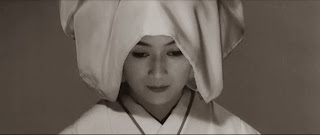A Samurai's son is forced to marry his son to the former mistress of his lord.
I was already fascinated by the title sequence. The succession of images of roofs and shingles were visually mesmerizing and subtly establish one of the underlying themes of the story: Everybody has to stay aligned to tradition to keep the structure intact.
But Mifunes character is stubborn and his fellow Samurai call him that. Although he flatly refuses his lord to wed his son to the dismissed wife of his lord, he is genuinely impressed when he realizes that the couple has taken a liking to each other. He realizes pretty fast that his own life has been full of ambition but devoid of happiness. So again he starts to struggle to make his son's life better than his.
At some point the reason for Mifune's stubbornness becomes moot and he keeps on fighting for a higher ideal: Feelings of even a simple vassal should be honored even by the highest lord. During this quixotic battle he becomes a hero of tragic but nevertheless heartwarming humanity.
This is only the third Kobayashi film I have seen, but it is definitively a masterpiece of Japanese cinema. The camerawork is pragmatic, yet beautiful. He doesn't use Kurosawa-style choreography, except for the fighting scenes, which come late and are over quite fast. Some of the editing decisions seem a bit outdated, but they are still bold and make their point (resorting to still frames, blur cuts, etc)
Kurosawa talks about the structure of the Koh play, which might be something I want to study in more detail. If this film follows this set-up there is a treasure of ideas to be found there.
I was already fascinated by the title sequence. The succession of images of roofs and shingles were visually mesmerizing and subtly establish one of the underlying themes of the story: Everybody has to stay aligned to tradition to keep the structure intact.
But Mifunes character is stubborn and his fellow Samurai call him that. Although he flatly refuses his lord to wed his son to the dismissed wife of his lord, he is genuinely impressed when he realizes that the couple has taken a liking to each other. He realizes pretty fast that his own life has been full of ambition but devoid of happiness. So again he starts to struggle to make his son's life better than his.
At some point the reason for Mifune's stubbornness becomes moot and he keeps on fighting for a higher ideal: Feelings of even a simple vassal should be honored even by the highest lord. During this quixotic battle he becomes a hero of tragic but nevertheless heartwarming humanity.
This is only the third Kobayashi film I have seen, but it is definitively a masterpiece of Japanese cinema. The camerawork is pragmatic, yet beautiful. He doesn't use Kurosawa-style choreography, except for the fighting scenes, which come late and are over quite fast. Some of the editing decisions seem a bit outdated, but they are still bold and make their point (resorting to still frames, blur cuts, etc)
Kurosawa talks about the structure of the Koh play, which might be something I want to study in more detail. If this film follows this set-up there is a treasure of ideas to be found there.





Kommentare